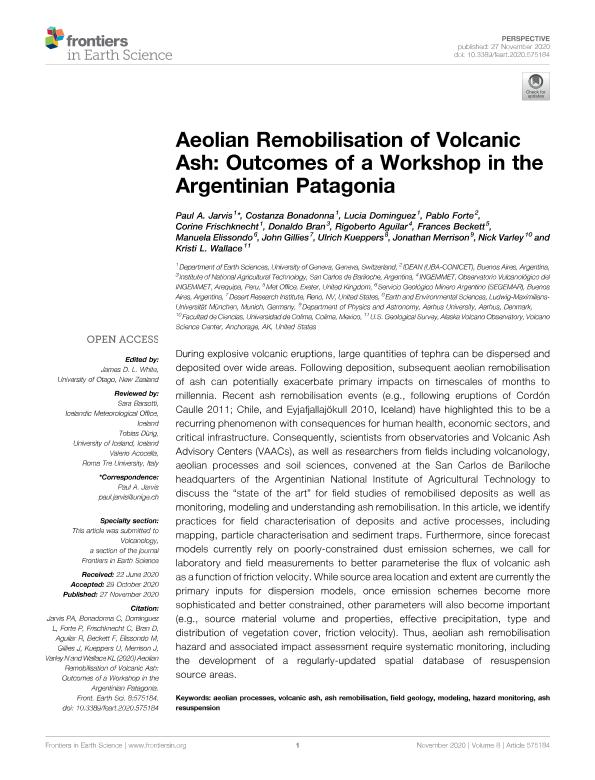Artículo
Aeolian Remobilisation of Volcanic Ash: Outcomes of a Workshop in the Argentinian Patagonia
Jarvis, Paul A.; Bonadonna, Costanza; Dominguez, Lucia; Forte, Pablo Brian ; Frischknecht, Corine; Bran, Donaldo; Aguilar, Rigoberto; Beckett, Frances; Elissondo, Manuela; Gillies, John; Kueppers, Ulrich; Merrison, Jonathan; Varley, Nick; Wallace, Kristi L.
; Frischknecht, Corine; Bran, Donaldo; Aguilar, Rigoberto; Beckett, Frances; Elissondo, Manuela; Gillies, John; Kueppers, Ulrich; Merrison, Jonathan; Varley, Nick; Wallace, Kristi L.
 ; Frischknecht, Corine; Bran, Donaldo; Aguilar, Rigoberto; Beckett, Frances; Elissondo, Manuela; Gillies, John; Kueppers, Ulrich; Merrison, Jonathan; Varley, Nick; Wallace, Kristi L.
; Frischknecht, Corine; Bran, Donaldo; Aguilar, Rigoberto; Beckett, Frances; Elissondo, Manuela; Gillies, John; Kueppers, Ulrich; Merrison, Jonathan; Varley, Nick; Wallace, Kristi L.
Fecha de publicación:
11/2020
Editorial:
Frontiers Media S.A.
Revista:
Frontiers in Earth Science
ISSN:
2296-6463
Idioma:
Inglés
Tipo de recurso:
Artículo publicado
Clasificación temática:
Resumen
During explosive volcanic eruptions, large quantities of tephra can be dispersed and deposited over wide areas. Following deposition, subsequent aeolian remobilisation of ash can potentially exacerbate primary impacts on timescales of months to millennia. Recent ash remobilisation events (e.g., following eruptions of Cordón Caulle 2011; Chile, and Eyjafjallajökull 2010, Iceland) have highlighted this to be a recurring phenomenon with consequences for human health, economic sectors, and critical infrastructure. Consequently, scientists from observatories and Volcanic Ash Advisory Centers (VAACs), as well as researchers from fields including volcanology, aeolian processes and soil sciences, convened at the San Carlos de Bariloche headquarters of the Argentinian National Institute of Agricultural Technology to discuss the ?state of the art? for field studies of remobilised deposits as well as monitoring, modeling and understanding ash remobilisation. In this article, we identify practices for field characterisation of deposits and active processes, including mapping, particle characterisation and sediment traps. Furthermore, since forecast models currently rely on poorly-constrained dust emission schemes, we call for laboratory and field measurements to better parameterise the flux of volcanic ash as a function of friction velocity. While source area location and extent are currently the primary inputs for dispersion models, once emission schemes become more sophisticated and better constrained, other parameters will also become important (e.g., source material volume and properties, effective precipitation, type and distribution of vegetation cover, friction velocity). Thus, aeolian ash remobilisation hazard and associated impact assessment require systematic monitoring, including the development of a regularly-updated spatial database of resuspension source areas.
Archivos asociados
Licencia
Identificadores
Colecciones
Articulos(IDEAN)
Articulos de INSTITUTO DE ESTUDIOS ANDINOS "DON PABLO GROEBER"
Articulos de INSTITUTO DE ESTUDIOS ANDINOS "DON PABLO GROEBER"
Citación
Jarvis, Paul A.; Bonadonna, Costanza; Dominguez, Lucia; Forte, Pablo Brian; Frischknecht, Corine; et al.; Aeolian Remobilisation of Volcanic Ash: Outcomes of a Workshop in the Argentinian Patagonia; Frontiers Media S.A.; Frontiers in Earth Science; 8; 11-2020; 1-9
Compartir
Altmétricas



